Counseling > EXAM > HSCO 502 Test 1. Liberty University answers complete solutions (All)
HSCO 502 Test 1. Liberty University answers complete solutions
Document Content and Description Below
HSCO 502 Test 1 Question 1 1. Which of the following is a true statement about the stability of infant attachments? Secure attachments are more likely to change than insecure attachments. ... If attachments fail to form by the end of infancy they will never successfully form. Changes in family stressors that lead to changes in caregiving quality can lead to shifts in attachment quality. Caregiver interventions cannot change infant attachment quality. Question 2 Annette is a warm and affectionate mother to her sons, Jason and Keith. When she comes home from her job, she likes to spend time playing with them, preparing their favorite foods, and watching TV with them. She describes herself as a “soft touch” when it comes to her children. Lately she has been hearing complaints about 6-year-old Jason’s behavior in school. Annette thinks the teacher is being too hard on her son. She does not want anything to affect the good relationship she has with her children. Which style best describes Annette’s parenting? Authoritarian. Authoritative. Permissive. Neglecting-uninvolved. Question 3 Developmental researchers use the term “goodness of fit” to refer to The match between the mother’s and baby’s blood type. The similarity of the genotype of the mother and the genotype of the father. The match between the caregiver’s responses to a child and the child’s temperament. The tendency of the caregiver to coordinate eye contact and vocalization with a baby. Question 4 The measure of social status that combines aspects of education background, income, and occupation is called socioeconomic status. social standing. social class. economic class. Question 5 According to Vygotsky, language is one product of shared understanding among members of a social group and may be considered a ____________ that facilitates learning and thinking. Scaffold Tool or sign Culture Developmental line Question 6 Which of the following statements is NOT indicative of intergenerational transmission: Adults whose caregivers were neglectful and abusive do not have strategies for managing children’s emotions or behavior from competent models. Intergenerational transmission is less likely for mothers with strong dissociative tendencies. Maltreated children become maltreating parents, they pass on their insecure attachment styles. A good martial relationship can modify adult attachment status and help an individual integrate early negative experiences into a coherent self-view. Question 7 Theories of development differ from opinion primarily because: they provide a complete picture of development. they have been proven to be true. they are based on scientific research. they are more abstract than opinions. Question 8 Guidelines for the application of developmental research in helping professions include keeping abreast of issues in the field and taking a multidimensional view of the influences on an individual. always assessing the developmental stage of each client. giving developmental theories an equal weight with your personal opinions. recognizing that developmental stage limits therapeutic progress. Question 9 1. At 10 months old, Suzie is very active, responds intensely to stimulation, avoids new stimulation, and tends to be irritable and fussy. Her temperament would be called Difficult. Easy. Slow-to-warm up. Resilient. Question 10 1. Basic emotions such as _____________ can be observed in young infants, but self-conscious emotions such as ____________ only emerge in childhood. Surprise and fear / embarrassment and pride Fear and shame /anger and empathy Contentment and pride / anger and shame Empathy and anger / surprise and fear Question 11 1. Which of the following statements is most accurate with regard to Piaget’s theory? Piaget firmly believed that children who were at a particular stage of cognitive development had the same level of understanding in all areas, such as understanding causality, morality, agency, etc. Piaget believed that children’s progress through the stages could vary. For example, very intelligent children could skip a stage. Piaget believed in the dynamic quality of stages and understood that children in the same stage could vary greatly in their specific understanding of causality, morality, and so forth. Piaget believed that children could vary in their understanding of morality but that their understanding of causality was the same for all children within a particular stage. Question 12 1. Sally, age 28, recently married John, age 45. They would like to have a child, but they are concerned that they may be at high risk to have a child with a chromosomal abnormality, like Down’s syndrome, because of John’s age. What is their genetic counselor likely to tell them? They are at higher than average risk for some chromosomal disorders because of John’s age, but not for Down’s syndrome. They are at higher than average risk for chromosomal disorders of all sorts because of John’s age. There is no relationship between parents’ age and chromosomal disorders in their offspring. The risk of any chromosomal disorder in a child is only related to the mother’s age, not to the father’s age. Question 13 1. In Bowlby’s attachment theory, which of the following represents a primary outcome of the formation of attachments in infancy? A working model of self, of others, and of relationships. Basic trust in others, but not a sense of self or of relationships. A sense of the power structure of a family. A belief in God. Question 14 1. Counselors must recognize the principle of ___________: Individual pathways of development may result in a wide range of possible outcomes. equifinality hierarchical integration dysfunctionality dysfunctionality multifinality Question 15 1. Stage theories of development typically describe ____________ changes in behavior, cognition, or social relationships. quantitative incremental qualitative cumulative Question 16 1. Which of the following is an accurate description of the long-term effects of chronic stress on the body? The ability of the immune system to fight infection and ward off disease is compromised. There are no effects on the immune system, and only short-term effects on the cardiovascular system. There are no effects on the cardiovascular system, but long-term effects on the skeletal muscles. There are no lasting effects on the body – when the stress ends all physical systems return to normal. Question 17 1. For most mental illnesses and behavioral disorders, like alcoholism and clinical depression, the genetic contribution can best be described as the result of a pair of recessive, defective genes. the result of a dominant, defective gene. the result of a single gene mutation. polygenic. Question 18 1. The still-face paradigm has been used primarily to study Emotion regulation in infants. Mother-infant attachment. The effects of disciplinary style on self-control. Temperament. Question 19 1. Which statement is TRUE regarding the characteristic of attachment style: Infants produce contradictory behavior showing both an inclination to approach the mother when stress and a tendency to avoid her when she approaches when they have a disorganized-disoriented attachment style. Infants with an avoidant-insecure attachment excessively cry when separated with their care-provide and cling to their mother when she returns. Anxious-ambivalent attachment styles demonstrate subtle reaction to being separated from their mothers, and upon return, they are happy and eager to see her. Infants who show very little negative reaction to their mother leaving and smile when she returns are securely attached. Question 20 1. Which of the following best represents early prenatal brain development? Brain development begins during the 4th month of gestation. At birth, a baby’s brain has 1 million neurons. Develop progresses from the outside in, pushing cells to find their proper location. The hindbrain, midbrain, and forebrain emerge from the neural tube around the 25th day of gestation. Question 21 1. In lifespan developmental theories, significant developmental changes are thought to be largely complete by the age of 18. the age of 30. the age of 50. Death. Question 22 1. In Bronfenbrenner’s model, proximal processes refer to independent changes in mental processes. favorable developmental conditions that are more likely to exist in one particular stage of development than in another. reciprocal interactions between an organism and its immediate environment. indirect influences on an organism. Question 23 1. When considering the age of entry and the amount of time spent in day care, researchers have identified a dose-response relationship which is associated with what outcome? depression at school age academic achievement in elementary school aggression and neediness at school age sociability with peers at school age Question 24 1. The ability to use language to communicate effectively by using well-organized narratives primarily depends upon the development of ____________ skill. Phonological Semantic Pragmatic Syntactic Question 25 1. Assimilation can be described as ____________ and accommodation can be described as ____________. Incorporating information / quantifying information. Incorporating information / restructuring information. Restructuring information / incorporating information. Quantifying information / restructuring information. Question 26 1. Video response. Review the video on, page 135 of your book; from the 3 statements select which one(s) are correct. Statement 1: children across all cultures, experience separate anxiety, around 12 months old; this is consistent because of human genetic factors. Statement 2: Cultural factors can influence children’s response to strangers, and the existence of separation anxiety. Statement 3: Only children who live in orphanages have a lower anxiety response. Statement 1 is correct. Statement 1 & 2 are correct Statement 2 is correct Statement 3 is correct. Question 27 1. In considering the major structures of the brain, which of these statements is FALSE. the medulla, pons and cerebellum are all part of the hindbrain network. The midbrain is the relay station and the forebrain control complex thoughts, motives and emotions. The limbic system is constructed of the activities located in the midbrain area, that impact complex thought processes. The pituitary gland regulates the endocrine systems. Question 28 1. Recessive, defective gene alleles can cause hereditary disorders. It is estimated that most people carry ____________ recessive, defective alleles in their genotypes. zero three to five hundreds of thousands of Question 29 1. Video response. Review the video on, page 79 of your book; from the 3 statements select which ones are correct. Statement 1: The students demonstrate Piaget’s concreate operational thought, only being able to understand previous learning and what they observe to be true at this time. Statement 2: The students demonstrate three processes of understanding: adaption, assimilation and accommodation related to their knowledge of tadpole development and the new information provided by the teacher, about their growth. Statement 3: The students were not able to understand that tadpoles lost their tail and became shorter. This demonstrates that the at their age, they are incapable of using this new information. Statement 1 is correct. Statement 2 is correct Statement 3 is correct Statement 1,2, and 3 are correct. Question 30 1. In one study, young rats exposed to stress vocalized their anxiety. Their mothers, alerted to this distress, responded with diligent caregiving behavior that altered the development of the hippocampus. Which of the following processes or principles does this example demonstrate? Dominant-recessive gene relationships. Active gene effects. The role of regulator genes in behavior genetics. Epigenesis. Question 31 1. Video response. Review the video on, page 15 of your book; from the 3 statements select which one(s) are correct. Statement 1. The teach illustrates social learning theory by modeling the process she would use to study the lesson and presents it to the group. Statement 2. In order for modeling to be effective, there must be a reward attached to motivate a child to repeat the behavior. Statement 3. The video suggests that modeling experiences could have been improved if the teacher would have worked one to one with each student opposed to having them observe this exercise as a group. Statement 2 and 3 are correct Statement 1 is correct Statement 2 is correct Statement 3 is correct Question 32 1. The adult attachment inventory (AAI) is used to assess the quality of attachment that parent have established with their own infants. Which statement is INCORRECT regarding the finds of Main and her colleagues: Secure-autonomous parents have coherent positive reflection, can talk openly about early experiences, and have faith in the power of relationships. Pre-occupied-entangled parents often still struggle to please, are passive, and their infant’s attachment style to them is ambivalent. Parents with an unresolved-disorganized pattern, tend to have infants with an anxious-ambivalent attachment style in stranger situation tests. Parents whose concepts of relationship are coherent and who have come to terms with past relationships, behave consistently with their infants and foster a secure attachment. Question 33 1. Jacinta, the mother of a 10-month-old baby boy, is concerned about her son’s increasing fussiness when she leaves him with his babysitter each morning. Which explanation of his behavior is most likely to be accurate? He is showing separation distress because his recognition memory is improving during this period. He is showing separation distress because his has an insecure attachment. He is showing lack of habituation to his caregiver which suggests the need to seek out a new babysitter. He is showing increased willfulness suggesting the need for greater discipline from his parents Question 34 1. Which statement regarding the understanding of objects, in infancy is FALSE? Object permanence underlies a baby’s ability to form an attachment to a specific adult, like a parent or other caregiver Infants younger than 8 months old, typically fail to search for objects that go out of sight. The development of one sensory system does not influence the development of other systems. A child must have a mental representation of the object in order to keep it in mind, when it is not present. Question 35 1. Infants form multiple attachments, to both mother and father and perhaps to a sibling, grandparent, and so on. Which of the following statements is most consistent with available data on the impact of these attachments? The primary attachment (usually with the mother) is the only one that is predictive of later development. The good effects of a secure attachment with one parent are canceled by the bad effects of an insecure attachment with the other parent. More than one secure attachment adds value, serving as a further protective factor. No data are available. Question 36 1. Which of the following statements is true about the effects of teratogens on the developing fetus? Any given teratogen usually has the same effect regardless of when in prenatal development exposure occurs. The kind of damage done depends on the stage of development during exposure. A teratogen will usually have the same effect regardless of how much exposure the fetus has to that teratogen. Ancient Greeks believed in teratogens, but modern science has been unable to identify any. Question 37 1. One important lesson that people in helping professional can take from Piaget’s and Vygotsky’s work is that Children must be expected to make independent progress, and not to be supported by adults in every task. Understanding how young clients think can help in structuring interventions that build effectively on existing knowledge and meanings. Stages of cognitive development proceed regularly, and are not altered by individual experiences. Language learning is not necessary for children to make progress in problem solving. Question 38 1. Which of the following statements is FALSE regarding chronic stress during pregnancy and its impact on the fetus? Stress during pregnancy, has no lasting effects on the fetus. There is a dose-response relationship between prenatal stress and maladaptive outcomes. Maternal stress at 16 weeks were more strongly related to later problems than those experiences at 34 weeks. Maternal stress causes long term psychopathology. Question 39 1. Video response. Review the video on, page 11 of your book; from the 3 statements select which one(s) are correct. Statement 1. The children were unable to successfully set the table and the teacher had to help. This demonstrates that the children mistrust their ability to perform the task. Statement 2. These children are at the age where they are demonstrating initiative vs. guilt, taking on grown-up roles. Statement 3. The children are demonstrating the emergence of autonomy with muscular control and both cognitive and language skills that help them take initiative. statement 2 and 3 are correct statement 3 is correct statement 1 is correct statement 1 and 2 are correct Question 40 1. Using Erikson’s developmental theory as a framework, which of the following statements is an accurate representation of his ideas? An individual cannot progress to a later stage unless the earlier stage has been resolved successfully and completely. Successful progression through the stages of development depends upon effective resolution of the Oedipal crisis. Successful resolution of a psychosocial crisis at each stage depends upon having more positive than negative experiences in the area of major concern. Highly intelligent individuals can skip specific stages and make progress at a faster rate than other people. Question 41 1. In considering infant mental health, helping professionals who work with young children should take an active role in Providing support and information for parents. Creating therapeutic experiences for the child that teach self-monitoring. Providing the child with group exposure to other children of the same age. Becoming an attachment figure for the young child. Question 42 1. Which statement about cross-cultural influence on infant attachment is TRUE: In cross-cultural studies, insecure attachment styles are the most prevalent. The tenets of attachment theory are not universal. Attachment theories contribution of relationship quality is only applicable to western cultures. In strange-situation-tests across cultures, a secure base is indicated by distress when she is separated and comfort when she returns. Question 43 1. High levels of the hormone oxytocin play an important role in early social bonding by Lowering infant dopamine levels. Promoting physical closeness and reducing maternal stress. Increasing infant stress responsivity. Regulating infant’s uneven hormonal and behavioral states Question 44 1. Myelinization is the process which involves neurons migrating to the temporal lobes. separating the left and right hemispheres of the cortex. coating the axon with a fatty sheath that improves conduction of electrical impulses. development of the nuclei of the brain. Question 45 1. When considering the level of trait in easy and difficult temperaments, as summarized in table 4.3, which statement is FALSE: The trait of attention span and persistence is long in easy temperament styles, and short in difficult temperament styles. The trait of threshold is the strength of the stimulus required for a child to attend or react; this is low in difficult temperament styles children. A difficult temperament style has a withdrawn or rejected reaction to new experiences. Easy temperament styles have a low regularity in their rhythmicity. Question 46 1. Mrs. Harmon, the mother of 18-month-old Bryce, is concerned that Bryce has not learned to speak very well. He has a limited vocabulary and seems content to point to the things he wants. Mrs. Harmon has read several child development books which indicate that Bryce should be in the stage of language learning. Mrs. Harmon fears that Bryce is not keeping up developmentally. Based on your understanding of the timing of developmental stages, what would be your best advice? Don’t pay attention to developmental milestones and treat each child as an individual. Since Bryce appears developmentally delayed, he should be referred immediately for a speech and language evaluation. Developmental stages can be useful guidelines, but there is a range of normal development within stages. Mrs. Harmon should use exercises such as flashcards with Bryce to increase his knowledge of vocabulary. Question 47 1. Contemporary developmentalists focus on which question concerning nature and nurture? Is nature the most important determinant of developmental change? Is nurture the most important determinant of developmental change? How do we explain the mechanisms by which nature and nurture interact to affect development? Why is nurture most influential at certain developmental periods? Question 48 1. Ms. Dawson recently gave birth to twins, a girl and a boy. Which of the following statements about them must be true? They share 100 per cent of their genes. They are monozygotic. They are dizygotic. They originated from a single zygote. Question 49 1. Bea is the mother of 4-month-old Alex. She has been depressed since Alex’s birth and is frequently withdrawn. Because of Bea’s depression, we can expect that, in comparison to other 4-month-olds, Alex experiences will display Less self-regulation. More active face-to-face interactions. Less crying and distress. More fearfulness and turning away. Question 50 1. Which of the following statements does not reflect contemporary critiques of Piagetian theory that have experimental support? Progress in intellectual development is often domain-specific. Preschoolers have less cognitive ability than Piaget had organically specified. Infants may have a rudimentary understanding of object permanence earlier in infancy than Piaget suspected. Infants frequently have the ability to mentally represent objects at birth. Click Save and Submit to save and submit. Click Save All Answers to save all answers. [Show More]
Last updated: 1 month ago
Preview 1 out of 18 pages
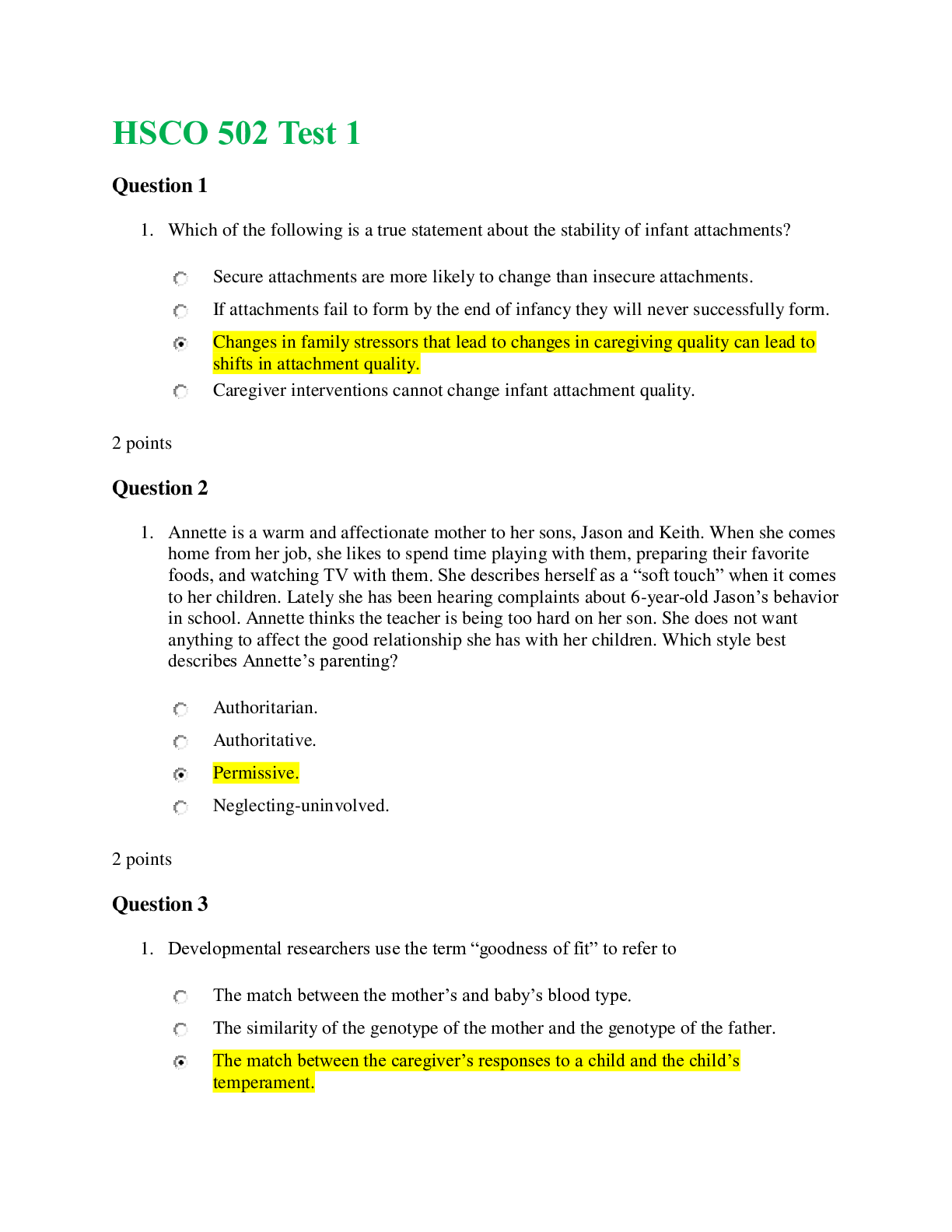
Reviews( 0 )
Document information
Connected school, study & course
About the document
Uploaded On
Feb 23, 2020
Number of pages
18
Written in
Additional information
This document has been written for:
Uploaded
Feb 23, 2020
Downloads
1
Views
174



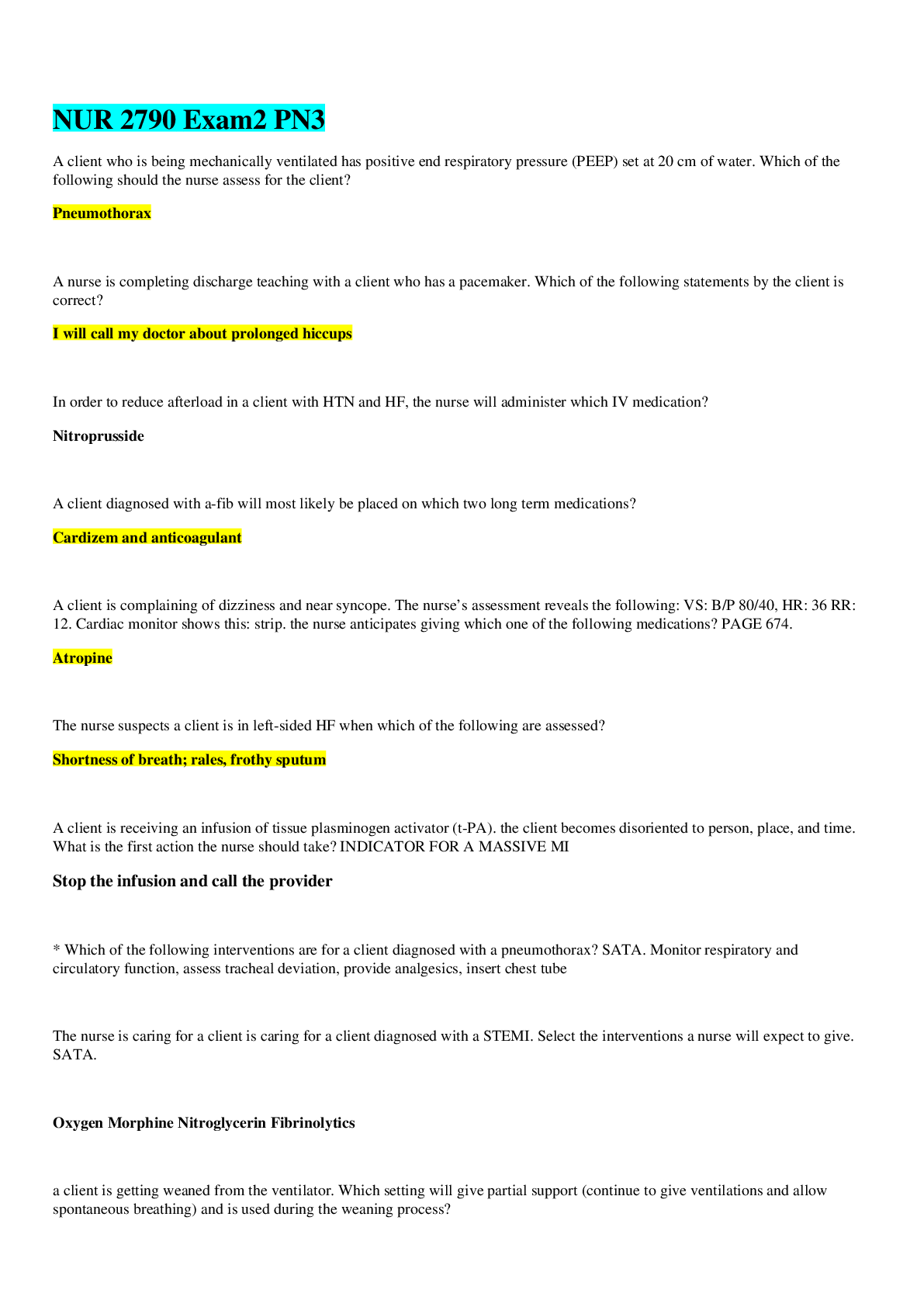

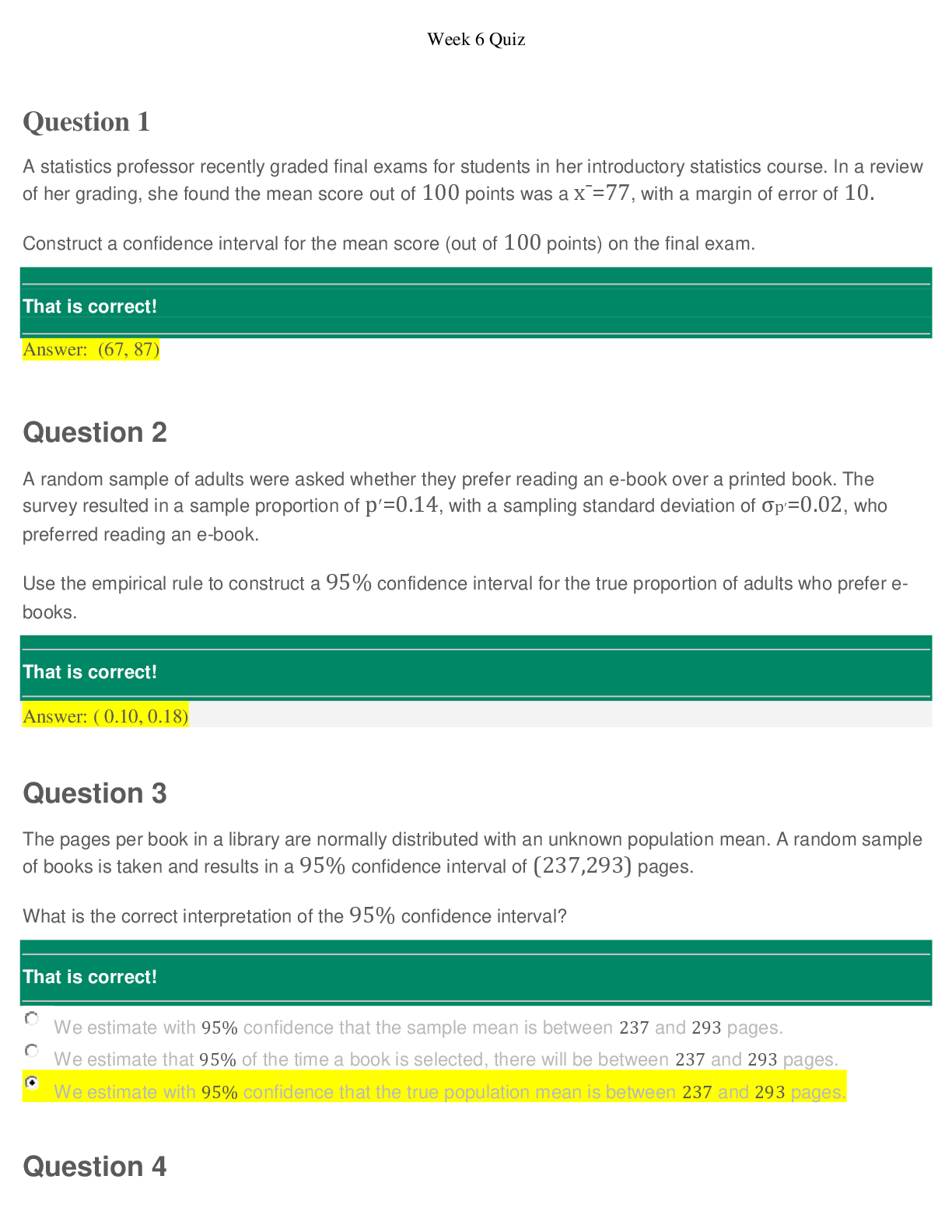





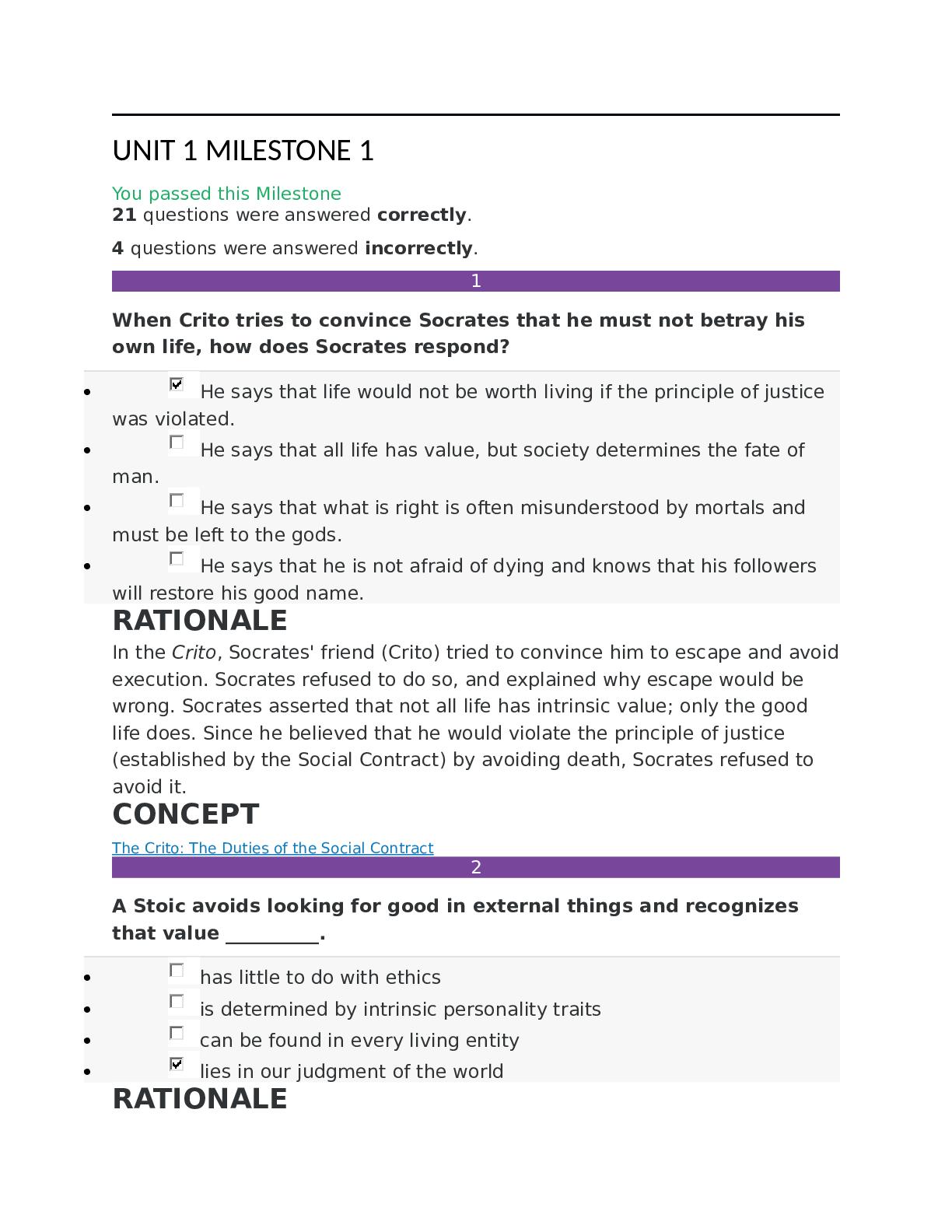
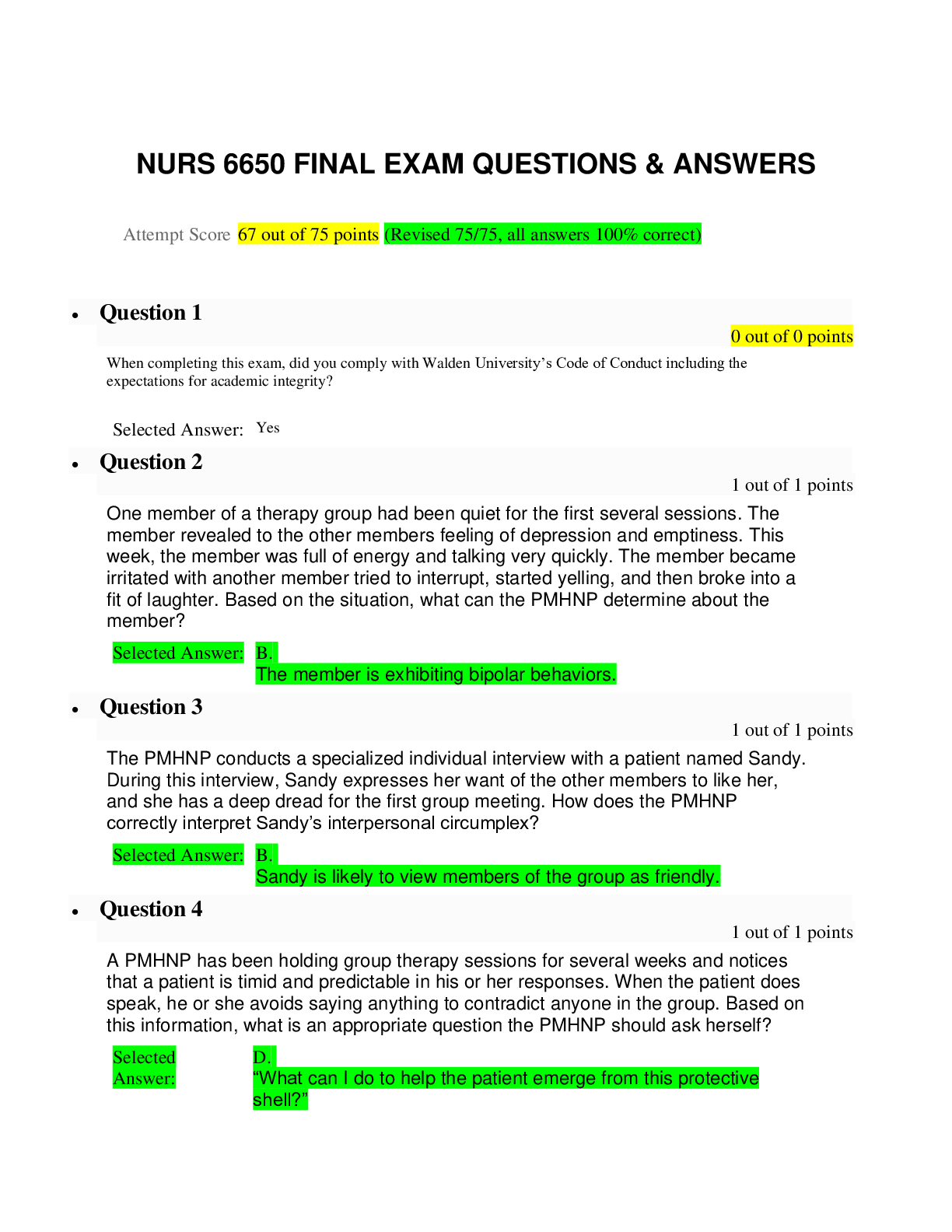
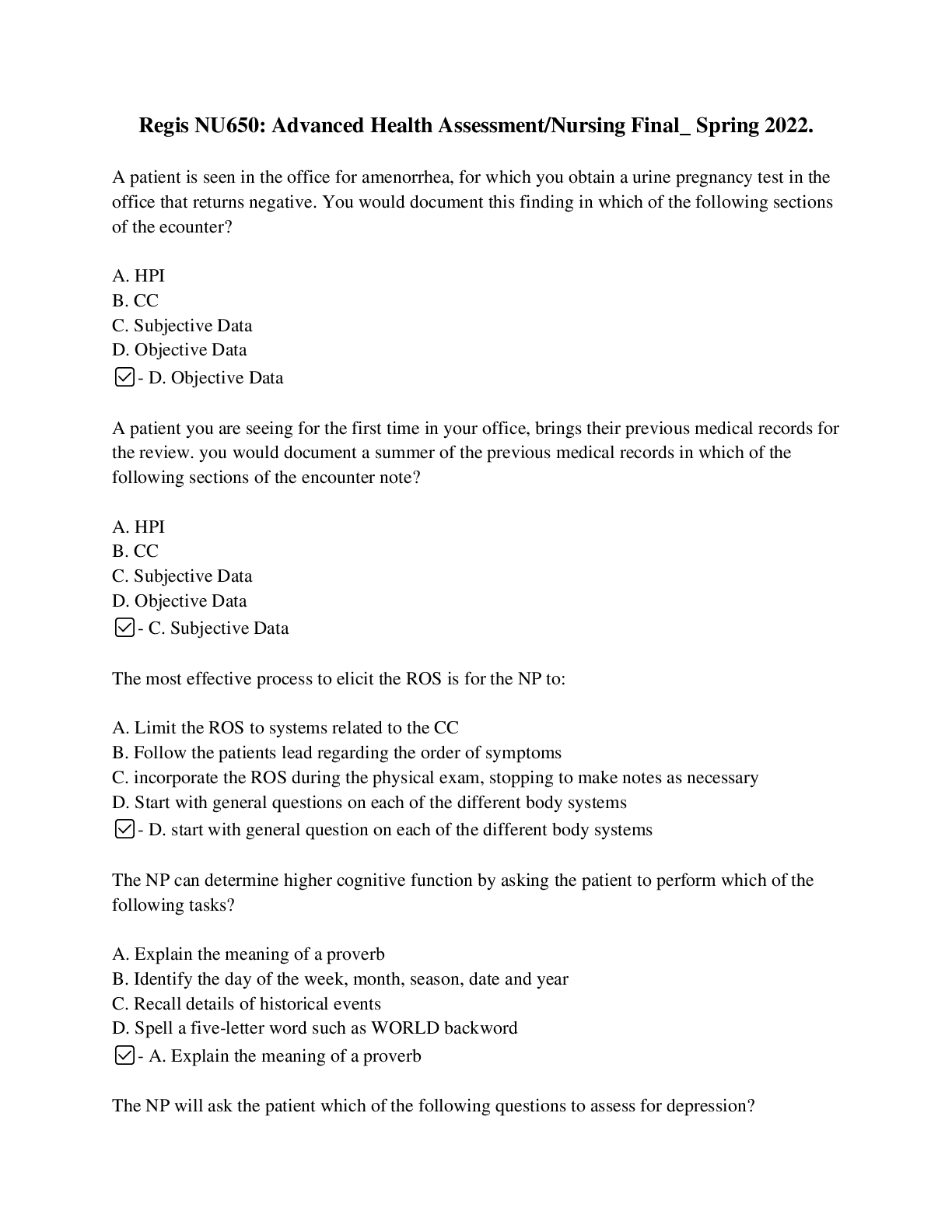
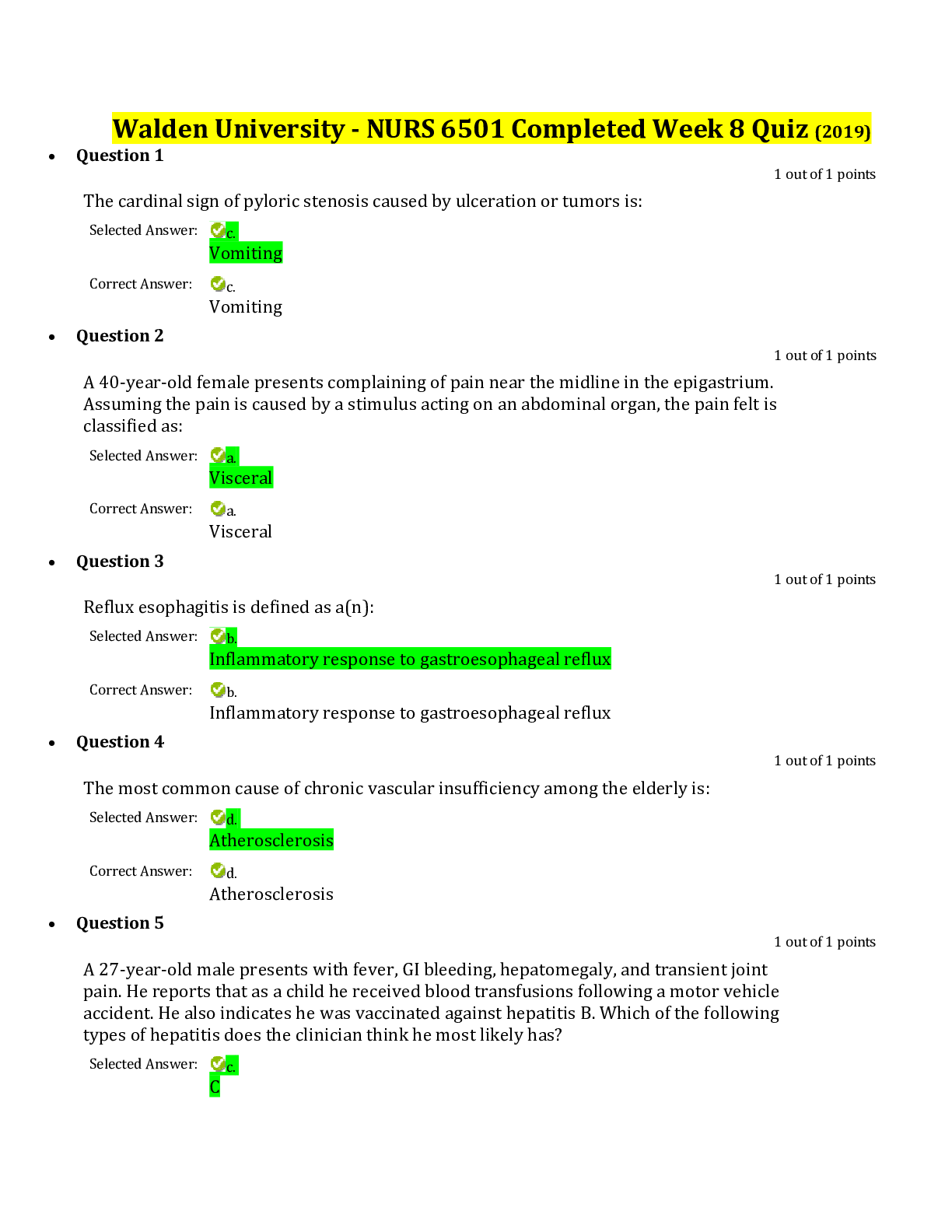
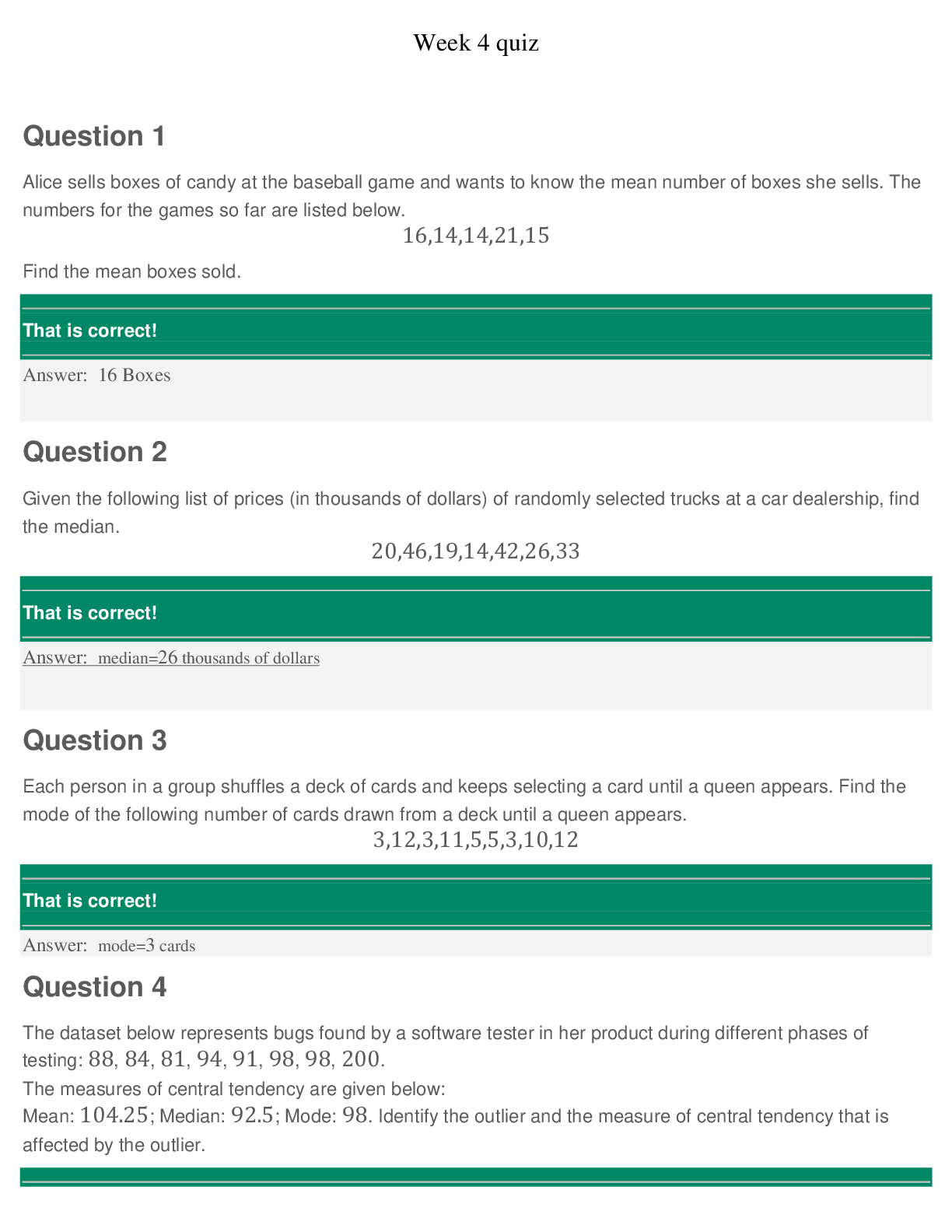
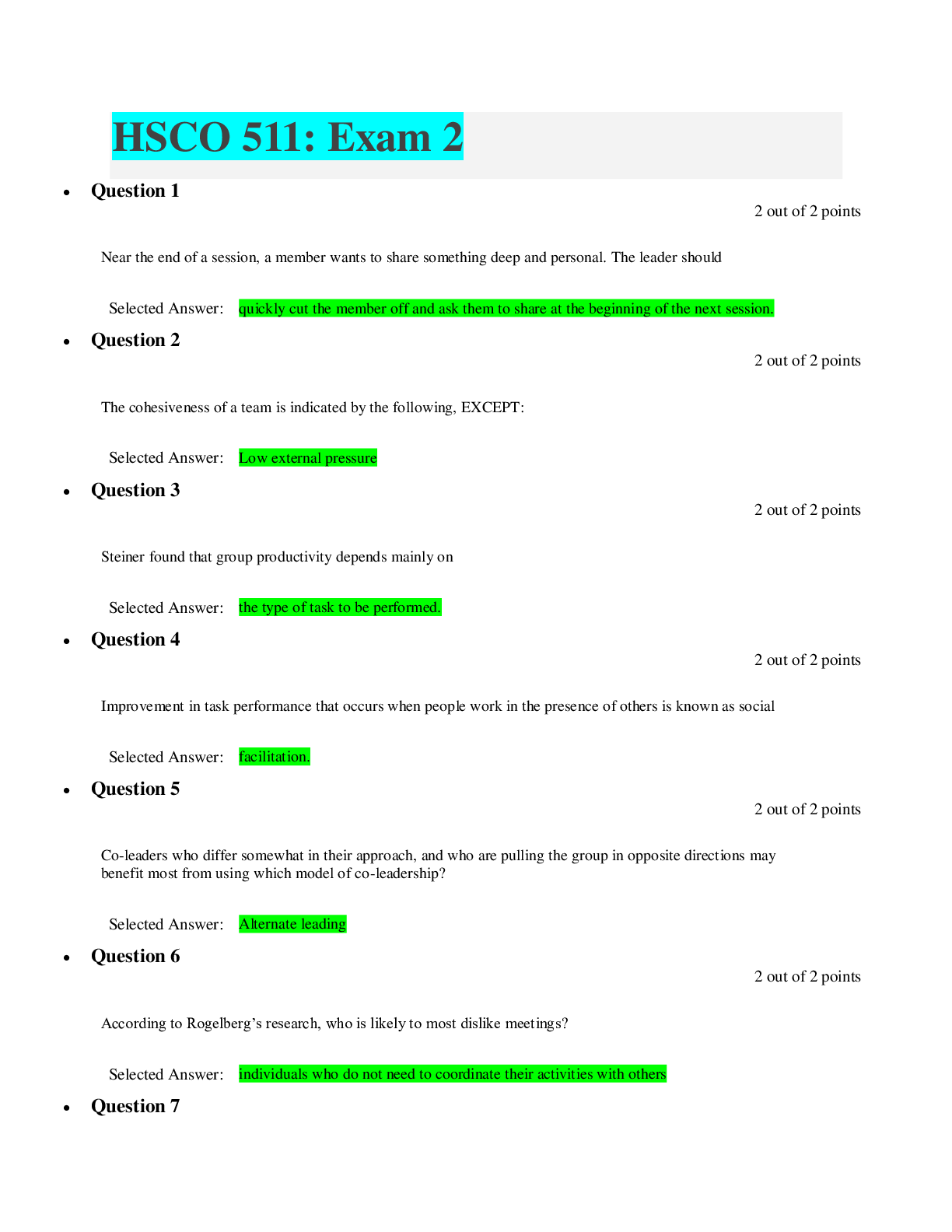
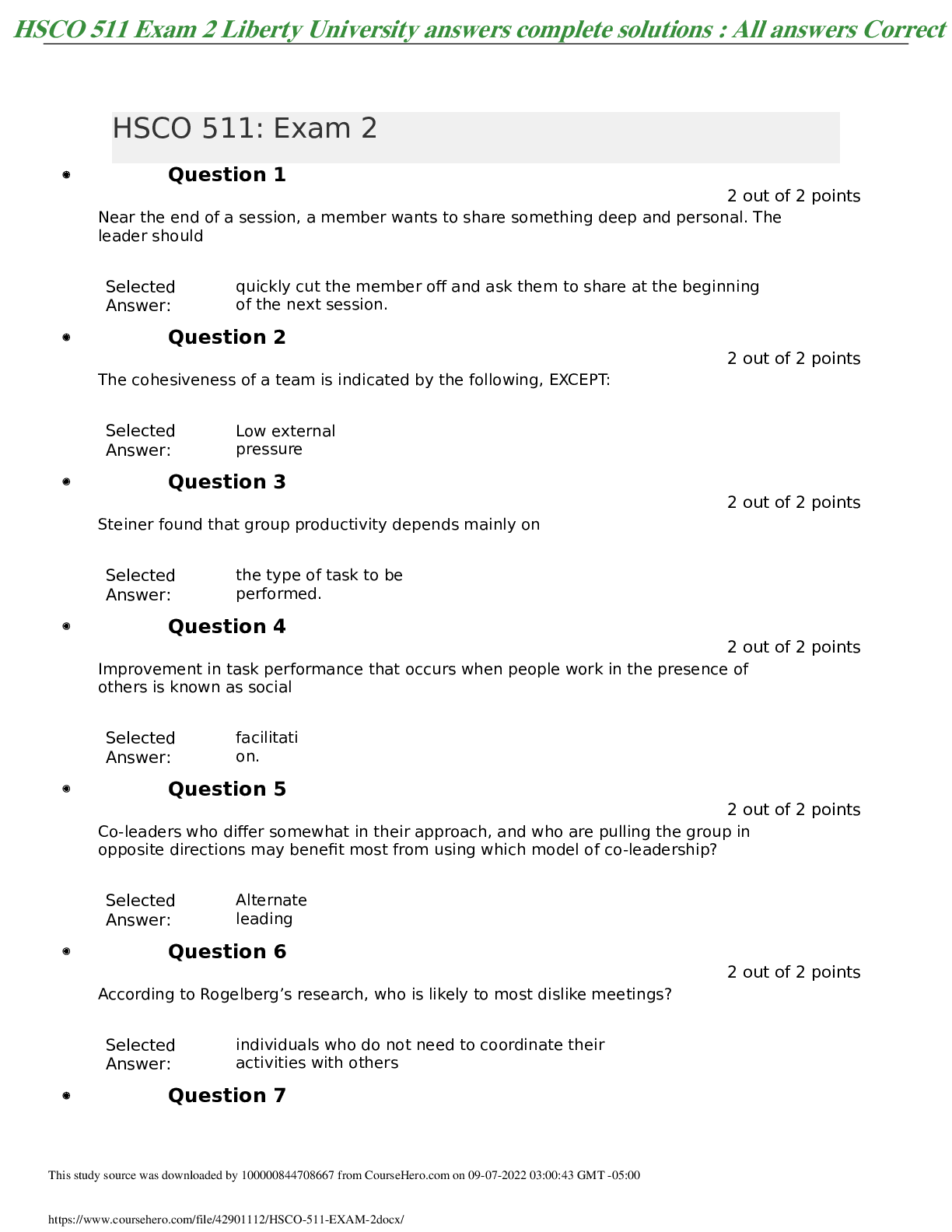
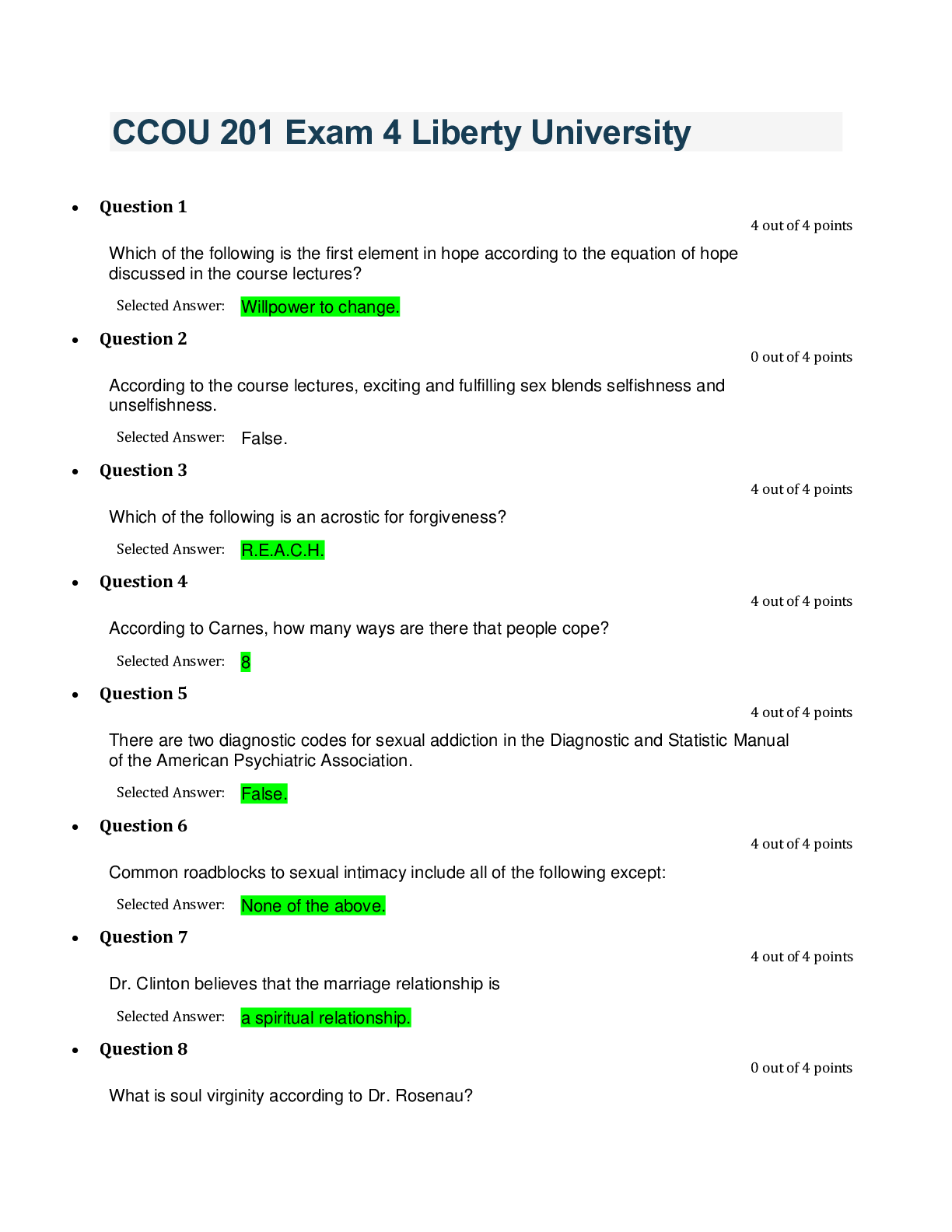



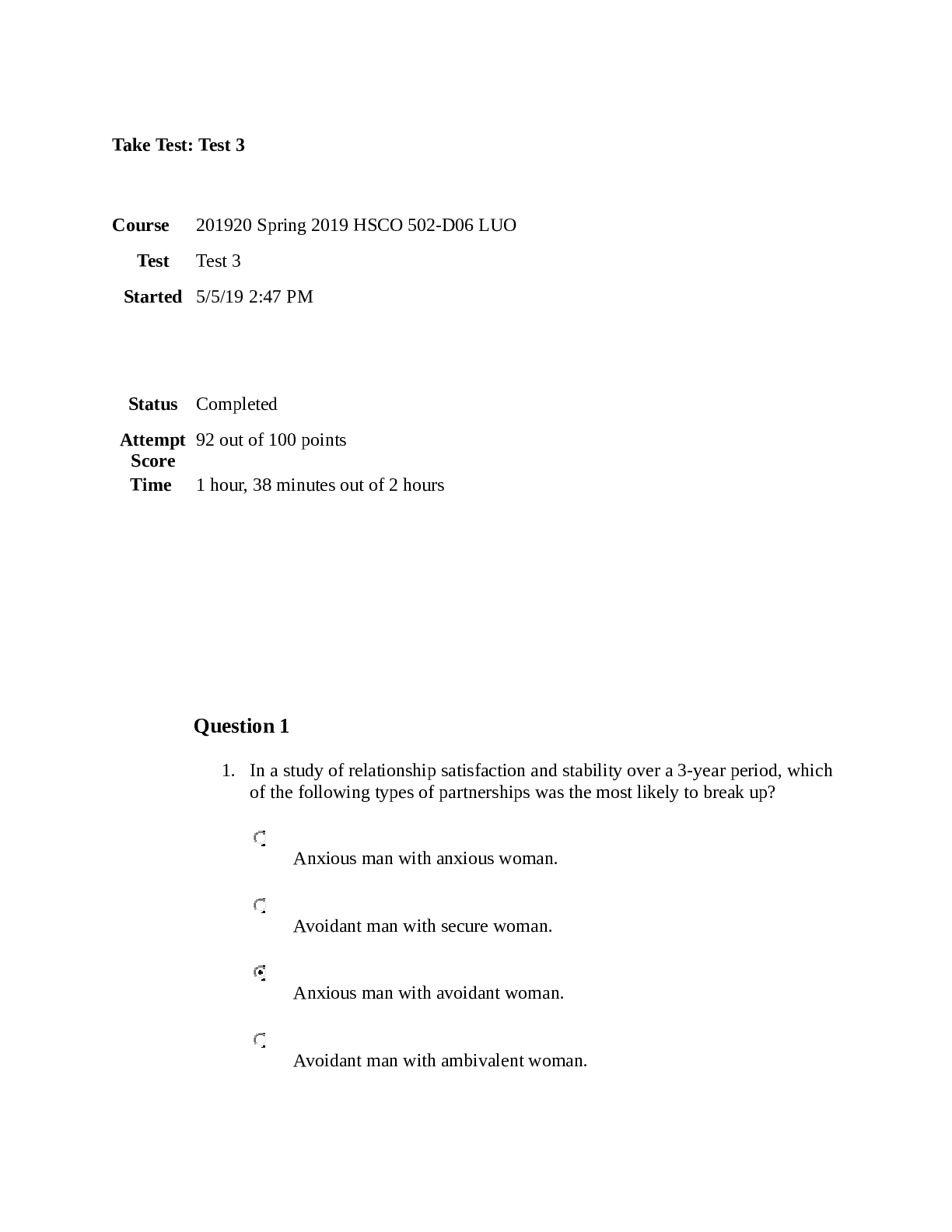
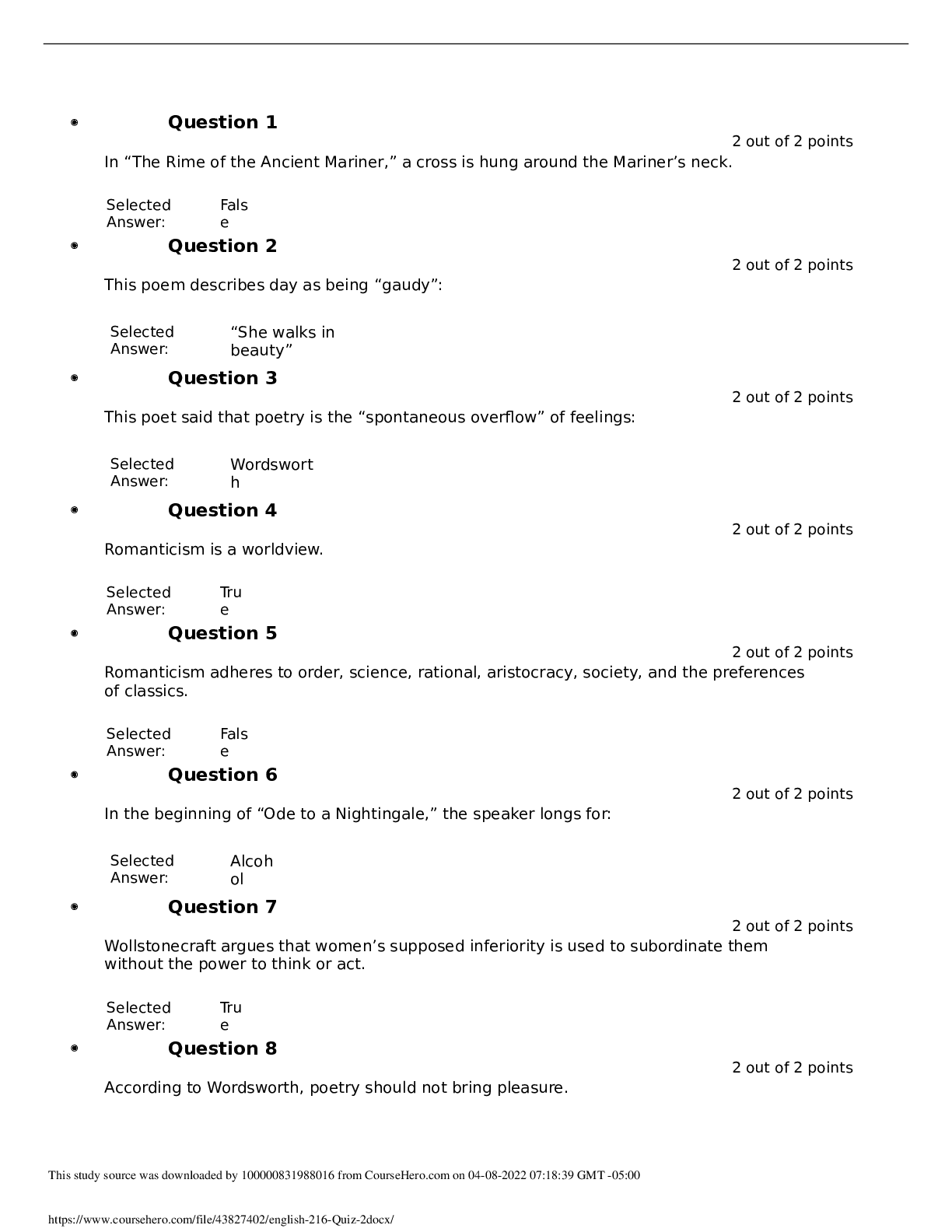

.png)

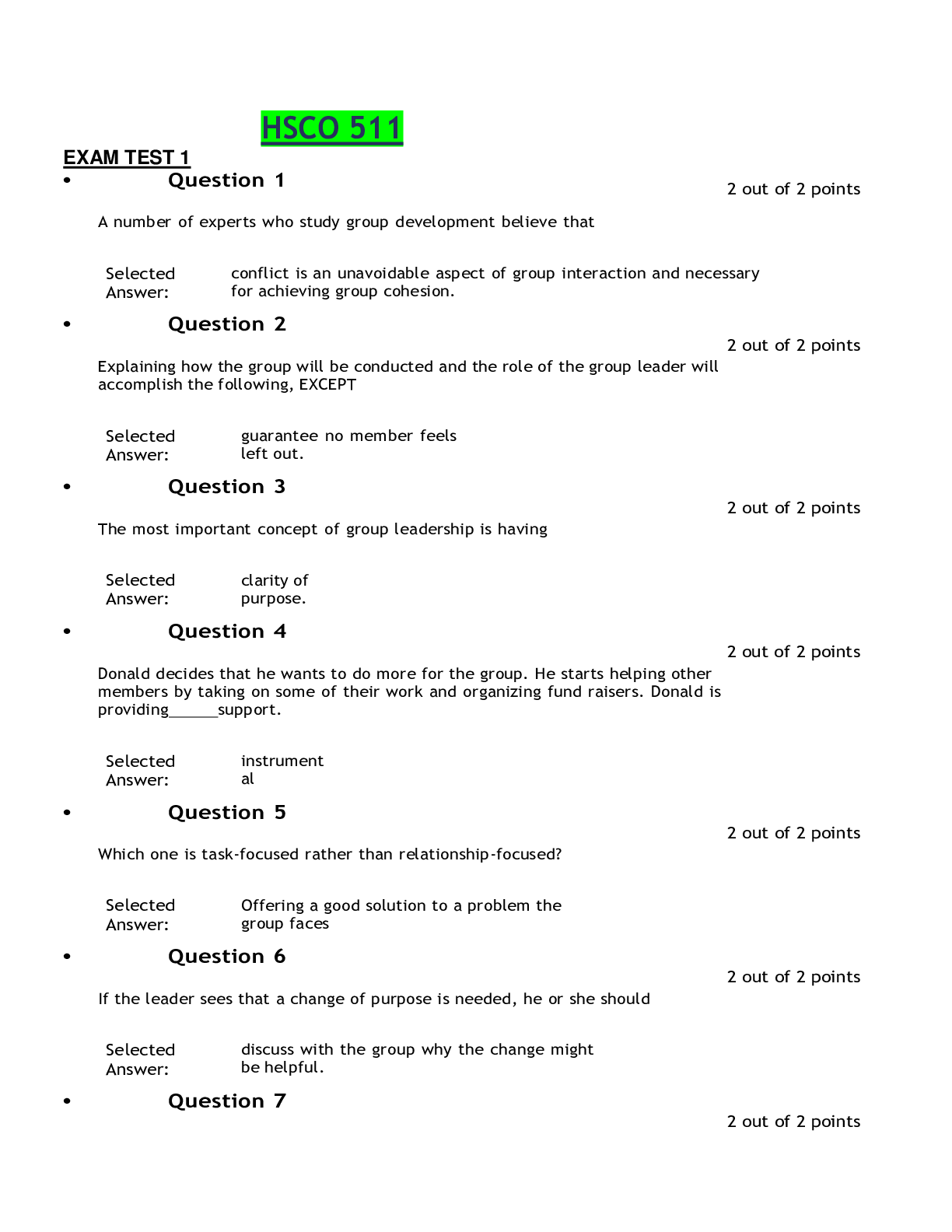


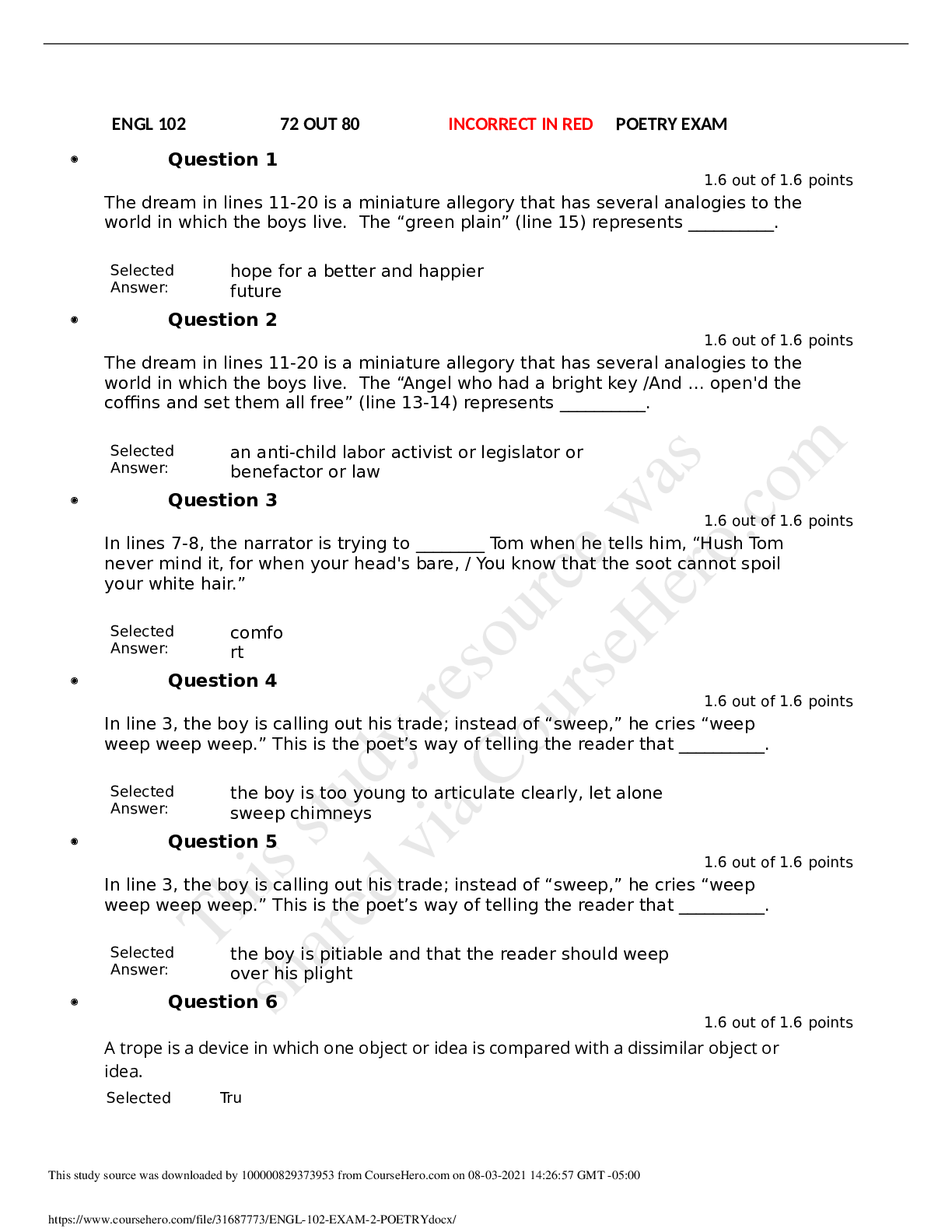

_removed.png)

